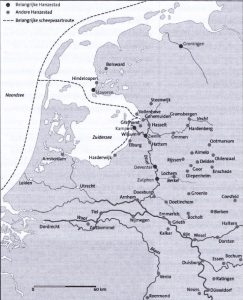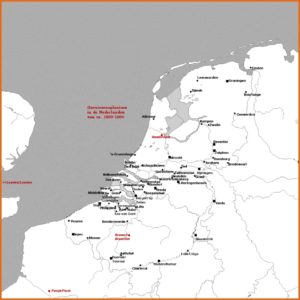Background – Spread of the Name
It’s hard to say over the last 1000 years how and why people with the name Van Dorsten are geographically spread, but there are a number of important causes. Also the mobility increased in the course of time, formerly most people remained in the same area to live and work. It depends of course on the origin, which is assumed to Dorsten (rich Hanseatic City since 12th/13th century), but also Dorst (poor agricultural community near Breda). You’ll then see that the spread from the city of Dorsten is much broader and with more various reasons (as described below), where the people from Dorst especially could be found in that area (with the name of Van Dorst, but with an exception for Van Dorsten in Dordrecht). The phonetic definition of names made it also not always clear.
Which in any case stands out, is that before 1500 already in multiple locations in Northern Europe (Rostock, Riga, Neuenhaus, Utrecht, Kampen, Arnhem, Zwolle) wealthy families Van Dorsten have been found. Indication of their wealth was also that they sometimes married people of nobility. This wealth must be (most probably) from the trade. The question is then whether there are multiple rich families, who are also spread about North Europe and called themselves Van Dorsten. The chance seems reasonable that this is traceable to the same family. In the Chronicle of Neuenhaus the genealogists related the richness as possibly from the later crusades in Eastern Europe, based on the family coat of arms.
Clergy
Faith used to be very important for the people. The place Dorsten belonged to the Archdiocese of Cologne and was an important city. The current Archdiocese of Utrecht then belongs to the Archdiocese of Cologne too and has only been separated in 1559. Both belonged to the Holy Roman Empire (extensive adm online). Between 1250 and 1550 there are several clerics found in the archives with the name and/or origin of Dorsten. These came often in other places or traveled for the faith through the region.
Trade
- In the period from 1200 until 1600 there was more and more trade. This happened particularly between the cities of the Hanseatic League, which generally were located at waterways. (see the picture below).
- In all large (trade) cities of the Netherlands many poorters (citizens) with the name Van Dorsten subscribed. It went particularly about merchants, marine vessels and specific professions that were needed (such as blacksmith, baize preparation, silk cloth merchants, etc.) and making that people could easily ask for citizenship to establish themselves elsewhere.

- There are several reports in the period of 1386 until 1406 in Riga (the Hanseatic City) of several Van Dorstens, including a Borchardus van Dorsten.
- There are also many reports between 1400 and 1500 in other Hanseatic towns such as Zutphen (Vorden nearby), Harderwijk, Den Bosch, Utrecht, Arnhem and Nijmegen (especially 1st half 15th century) and later on also Tiel, Gouda, Zwolle and Kampen (2nd half of 15th century). This went mainly via the rivers Rhine, Waal and IJssel.
- In the 16th century there was in any case of the tribe in Kampen still regular contact with family members in Münsterland (which also includes Dorsten).
- Around 1500 a tribe became known in Neuenhaus. This is probably due to the Overijsselse Vecht River, at that time an important connection for trade from Bentheim, especially for amber (Royal Palace, statue of liberty, New York). The river Vecht flows into the IJssel at Zwartsluis (where later also a tribe originated) and near Wanneperveen/Steenwijk (where another family originated).
- Throughout the whole region of Northern Europe (up to Riga) old Dutch (Germanic) was spoken, almost everywhere the same language. In the County of Bentheim until mid-18th century, then was only the later German spoken.
- Also in the administration of the Holy Roman Empire are several reports about Van Dorsten.
- There is evidence that people from the Western Hanseatic cities via the 2nd generation crusades (the Baltic countries) through the Holy Roman Empire and the Teutonic Order have settled in countries such as Estonia, Latvia and Lithuania and when there the fight was lost, came back wealthy.
- In the period from 1600 to 1800 was traded with the ‘ East ‘ (like the Dutch Indies via the Dutch East India Company) and the ‘ West ‘ (America through the Netherlands West India Company). You can find several reports for that period back in those administrations and people also settled there.
- Another basis for the spread was that children of the people with money (including richer traders) were studying at universities (such as Heidelberg, Cologne, Groningen and Leiden). The first magistrate of Heidelberg (1st University of Germany) was even one Hendrick van Dorsten (1386-1396)!
- That these families belonged to the wealthier citizens also revealed the fact that they became in multiple places the magistrates or Sheriffs.
Military
Also the sons who became soldiers, led to spread of the name and could unexpectedly pop up in other garrison cities or war areas. In the wars of faith (such as the thirty years war in Germany and the eighty years war in The Netherlands) certainly people with the name have been involved. A challenge was that the administration was not always complete (or lost) and that just a tribe could show up or disappear.
When the VOC and the WIC started to dominate the world trade (the golden age of Netherlands), there were also many soldiers (and other professions) in service that could be found in their administrations and settled in the various countries.
Wars & Disasters
 A reason for people to have somewhere to leave was doom from the outside, such as wars, looting, disease and fire. The most important (relevant) wars are also listed on the home page in the context image at the top and at the Background Context History. Listed below are some (possible) relevant effects appointed by wars and disasters:
A reason for people to have somewhere to leave was doom from the outside, such as wars, looting, disease and fire. The most important (relevant) wars are also listed on the home page in the context image at the top and at the Background Context History. Listed below are some (possible) relevant effects appointed by wars and disasters:
- The Guelders Wars between 1350 and 1550 determined the entire region and was perhaps the reason for the emergence of the tribe in Neuenhaus.
- The Eighty Years’ War from The Netherlands with Spain was the reason for the emergence of the tribe in Dordrecht, because Breda was conquered by the Spaniards and they had to flee.
- As a result of the Thirty Years War, a part of the Neuenhaus tree went to Emden in the North. This religious war probably had more impact.
- The Franco-Dutch War and the Nine Years’ War with France at the end of the 17th century might be related to the ancestor of the tribe in Steenwijk. This concerned a soldier, probably began during the first war and died during the second one.
- Various diseases had catastrophic consequences for the population. In particular by the plague a large part of the population could become extinct, this prevails in 1459 in Dorsten. Moreover, the administration of these (by Bruderschaft Beatae Mariae Virginis) was the first good registration of names in Dorsten.
- Particularly in the 15th and 16th centuries are in many cities great burns (most of the buildings were then still by wood), whereby a large part of the city could burn down and often documentation and Governments were destroyed.
Current Situation
On the site CBGfamilienamen.nl you can see how the spread nowadays is in the Netherlands.